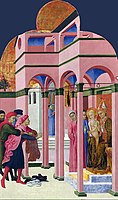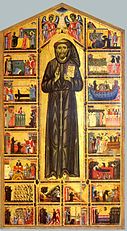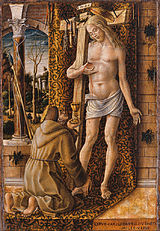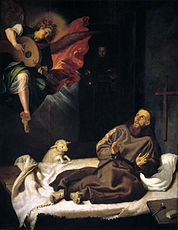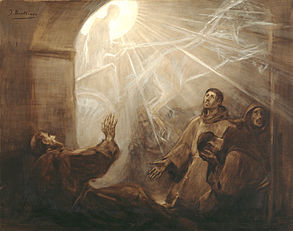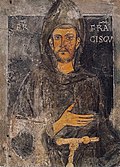Francis of Assisi
Dumanjug, Cebu, General Trias , and Italy |
|---|
| Part of a series on |
| Christian mysticism |
|---|
 |
| Part of a series on |
| Eucharistic adoration of the Catholic Church |
|---|
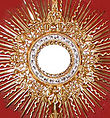 |
| Papal documents |
| Organisations and events |
|
| Notable individuals |
| Eucharistic meditators |
|
|
Catholicism portal |
Giovanni di Pietro di Bernardone (c. 1181 – 3 October 1226), known as Francis of Assisi,[b] was an Italian mystic, poet and Catholic friar who founded the religious order of the Franciscans. He was inspired to lead a Christian life of poverty as a beggar[7] and itinerant preacher. One of the most venerated figures in Christianity,[8][4] Francis was canonized by Pope Gregory IX on 16 July 1228. He is commonly portrayed wearing a brown habit with a rope tied around his waist, featuring three knots that symbolize the three Franciscan vows of poverty, chastity, and obedience.
In 1219, he went to Egypt in an attempt to convert the sultan al-Kamil and put an end to the conflict of the Fifth Crusade.[9] In 1223, he arranged for the first live nativity scene as part of the annual Christmas celebration in Greccio.[c][10][11] According to Christian tradition, in 1224 Francis received the stigmata during the apparition of a Seraphic angel in a religious ecstasy.[12]
He founded the men's
Francis is associated with patronage of animals and the
Names
Francis (
His full name contemporarily could be translated to John Peter "Francis" Bernardone.
Biography

Early life
Francis of Assisi was born c. 1181,[15][16] one of the children of an Italian father, Pietro di Bernardone dei Moriconi, a prosperous silk merchant, and a French mother, Pica di Bourlemont, about whom little is known except that she was a noblewoman originally from Provence.[17]
Indulged by his parents, Francis lived the high-spirited life typical of a wealthy young man.
Around 1202, he joined a military expedition against Perugia and was taken as a prisoner at Collestrada. He spent a year as a captive,[19] during which an illness caused him to re-evaluate his life. However, upon his return to Assisi in 1203, Francis returned to his carefree life. In 1205, Francis left for Apulia to enlist in the army of Walter III, Count of Brienne. A strange vision made him return to Assisi and lose interest in the worldly life.[12] According to hagiographic accounts, thereafter he began to avoid the sports and feasts of his former companions. A friend asked him whether he was thinking of marrying, to which he answered: "Yes, a fairer bride than any of you have ever seen", meaning his "Lady Poverty".[11]
On a pilgrimage to Rome, he joined the poor in begging at St. Peter's Basilica.[12] He spent some time in lonely places, asking God for divine illumination. He said he had a mystical vision of Jesus Christ in the forsaken country chapel of San Damiano, just outside Assisi, in which the Icon of Christ Crucified said to him, "Francis, Francis, go and repair My church which, as you can see, is falling into ruins." He took this to mean the ruined church in which he was presently praying, and so he sold some cloth from his father's store to assist the priest there.[20] When the priest refused to accept the ill-gotten gains, an indignant Francis threw the coins on the floor.[11]
In order to avoid his father's wrath, Francis hid in a cave near San Damiano for about a month. When he returned to town, hungry and dirty, he was dragged home by his father, beaten, bound, and locked in a small storeroom. Freed by his mother during Bernardone's absence, Francis returned at once to San Damiano, where he found shelter with the officiating priest, but he was soon cited before the city consuls by his father. The latter, not content with having recovered the scattered gold from San Damiano, sought also to force his son to forego his inheritance by way of restitution. In the midst of legal proceedings before the
For the next couple of months, Francis wandered as a beggar in the hills behind Assisi. He spent some time at a neighbouring monastery working as a
-
The house where Francis of Assisi lived when young
-
Saint Francis renounces his earthly father.
Founding of the Franciscan Orders
Friars Minor
One morning in February 1208, Francis was taking part in a Mass in the chapel of St. Mary of the Angels, near which he had by then built himself a hut. The Gospel of the day was the "Commissioning of the Twelve" from the Book of Matthew. The disciples were to go and proclaim that the Kingdom of God is at hand. Francis was inspired to devote himself to a life of poverty. Having obtained a coarse woolen tunic, the dress then worn by the poorest Umbrian peasants, he tied it around himself with a knotted rope and went about exhorting the people of the countryside to penance, brotherly love, and peace. Francis's preaching to ordinary people was unusual as he had no license to do so.[4]
His example attracted others. Within a year Francis had eleven followers. The brothers lived a simple life in the deserted leper colony of Rivo Torto near Assisi; but they spent much of their time wandering through the mountainous districts of Umbria, making a deep impression upon their hearers by their earnest exhortations.[11]
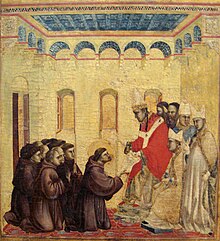
In 1209 he composed a simple rule for his followers ("friars"), the Regula primitiva or "Primitive Rule", which came from verses in the Bible. The rule was "to follow the teachings of our Lord Jesus Christ and to walk in his footsteps." He then led eleven followers to Rome to seek permission from
Poor Clares and Third Order
From then on, the new order grew quickly. Hearing Francis preaching in the church of
For those who could not leave their affairs, Francis later formed the Third Order of Brothers and Sisters of Penance, a fraternity composed of either laity or clergy whose members neither withdrew from the world nor took religious vows. Instead, they observed the principles of Franciscan life in their daily lives.[4] Before long, the Third Order – now titled the Secular Franciscan Order – grew beyond Italy.[26]
Travels
Determined to bring the Gospel to all peoples and let God convert them, Francis sought on several occasions to take his message out of Italy. In the late spring of 1212, he set out for Jerusalem, but was shipwrecked by a storm on the Dalmatian coast, forcing him to return to Italy. On 8 May 1213, he was given the use of the mountain of La Verna (Alverna) as a gift from Count Orlando di Chiusi, who described it as "eminently suitable for whoever wishes to do penance in a place remote from mankind".[27] The mountain would become one of his favourite retreats for prayer.[28]
In the same year, Francis sailed for Morocco, but an illness forced him to break off his journey while in Spain.
In 1219, accompanied by Friar Illuminatus of Arce and hoping to convert the Sultan of Egypt or be martyred in the attempt, Francis went to Egypt during the Fifth Crusade where a Crusader army had been encamped for over a year besieging the walled city of Damietta. The Sultan, al-Kamil, a nephew of Saladin, had succeeded his father as Sultan of Egypt in 1218 and was encamped upstream of Damietta. A bloody and futile attack on the city was launched by the Christians on 29 August 1219, following which both sides agreed to a ceasefire that lasted four weeks.[29] Probably during this interlude Francis and his companion crossed the Muslims' lines and were brought before the Sultan, remaining in his camp for a few days.[30] Reports give no information about what transpired during the encounter beyond noting that the Sultan received Francis graciously and that Francis preached to the Muslims. He returned unharmed.[d] No known Arab sources mention the visit.[31]

Such an incident is alluded to in a scene in the late 13th-century fresco cycle, attributed to Giotto, in the upper basilica at Assisi.[e]
According to some late sources, the Sultan gave Francis permission to visit the sacred places in the Holy Land and even to preach there. All that can safely be asserted is that Francis and his companion left the Crusader camp for Acre, from where they embarked for Italy in the latter half of 1220. Drawing on a 1267 sermon by Bonaventure, later sources report that the Sultan secretly converted or accepted a death-bed baptism as a result of meeting Francis.[f]
Due to these events in Jerusalem,[
Reorganization of the Franciscan Order
On 29 September 1220, Francis handed over the governance of the order to Brother Peter Catani at the Porziuncola, but Peter died only five months later.
Brother Peter was succeeded by
Stigmata, final days, and sainthood

While he was praying on the mountain of Verna, during a forty-day fast in preparation for
On 16 July 1228, he was declared a saint by Pope
Character and legacy
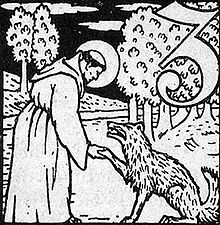

Francis set out to imitate Christ and literally carry out his work. This is important in understanding Francis' character, his affinity for the Eucharist and respect for the priests who carried out the sacrament.[4] He preached: "Your God is of your flesh, He lives in your nearest neighbor, in every man."[39]
He and his followers celebrated and even venerated poverty, which was so central to his character that in his last written work, the Testament, he said that absolute personal and corporate poverty was the essential lifestyle for the members of his order.[4]
He believed that nature itself was the mirror of God. He called all creatures his "brothers" and "sisters", and even preached to the birds[40][41] and supposedly persuaded a wolf in Gubbio to stop attacking some locals if they agreed to feed the wolf. His deep sense of brotherhood under God embraced others, and he declared that "he considered himself no friend of Christ if he did not cherish those for whom Christ died".[4]
Francis' visit to Egypt and attempted
At Greccio near Assisi, around 1220, Francis celebrated Christmas by setting up the first known presepio or crèche (
Nature and the environment
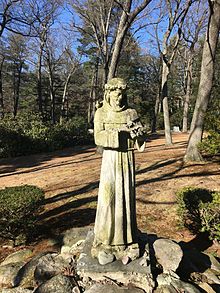
Francis preached the Christian doctrine that the world was created good and beautiful by God but suffers a need for redemption because of human sin. As someone who saw God reflected in nature, "St. Francis was a great lover of God's creation ..."[44] In the Canticle of the Sun he gives God thanks for Brother Sun, Sister Moon, Brother Wind, Water, Fire, and Earth, all of which he sees as rendering praise to God.[45]
Many of the stories that surround the life of Francis say that he had a great love for animals and the environment.
Another legend from the Fioretti tells that in the city of Gubbio, where Francis lived for some time, was a wolf "terrifying and ferocious, who devoured men as well as animals". Francis went up into the hills and when he found the wolf, he made the sign of the cross and commanded the wolf to come to him and hurt no one. Then Francis led the wolf into the town, and surrounded by startled citizens made a pact between them and the wolf. Because the wolf had "done evil out of hunger", the townsfolk were to feed the wolf regularly. In return, the wolf would no longer prey upon them or their flocks. In this manner Gubbio was freed from the menace of the predator.[46]
On 29 November 1979, Pope John Paul II declared Francis the patron saint of ecology.[47] On 28 March 1982, John Paul II said that Francis' love and care for creation was a challenge for contemporary Catholics and a reminder "not to behave like dissident predators where nature is concerned, but to assume responsibility for it, taking all care so that everything stays healthy and integrated, so as to offer a welcoming and friendly environment even to those who succeed us."[48] The same Pope wrote on the occasion of the World Day of Peace, 1 January 1990, that Francis "invited all of creation – animals, plants, natural forces, even Brother Sun and Sister Moon – to give honour and praise to the Lord. The poor man of Assisi gives us striking witness that when we are at peace with God we are better able to devote ourselves to building up that peace with all creation which is inseparable from peace among all peoples."[49]
In 2015,
It is a popular practice on his feast day, 4 October, for people to bring their pets and other animals to church for a blessing.[52]
Feast day

Francis'
Francis is
Papal name
On 13 March 2013, upon his election as Pope, Archbishop and Cardinal Jorge Mario Bergoglio of Argentina chose Francis as his papal name in honor of Francis of Assisi, becoming Pope Francis.[58][59]
At his first audience on 16 March 2013, Pope Francis told journalists that he had chosen the name in honor of Francis of Assisi, and had done so because he was especially concerned for the well-being of the poor.[59][60][61][62] The pontiff recounted that Cardinal Cláudio Hummes had told him, "Don't forget the poor", right after the election; that made Bergoglio think of Francis.[63][64] It is the first time a pope has taken the name.[g]
Patronage

On 18 June 1939, Pope Pius XII named Francis a joint patron saint of Italy along with Catherine of Siena with the apostolic letter "Licet Commissa".[66] Pope Pius also mentioned the two saints in the laudative discourse he pronounced on 5 May 1949, in the Church of Santa Maria sopra Minerva.[citation needed]
Francis is the patron of animals and ecology.[67] As such, he is the patron saint of the Laudato Si' Movement, a network that promotes the Franciscan ecological paradigm as outlined in the encyclical Laudato Si'.[68]
He is also considered the patron against dying alone; against fire; patron of the
He is the patron of many
Outside Catholicism
Anglicanism
One of the results of the Oxford Movement in the Anglican Church during the 19th century was the re-establishment of religious orders, including some of Franciscan inspiration. The principal Anglican communities in the Franciscan tradition are the Community of St. Francis (women, founded 1905), the Poor Clares of Reparation (P.C.R.), the Society of St. Francis (men, founded 1934), and the Community of St. Clare (women, enclosed).[71][citation needed]
A U.S.-founded order within the Anglican world communion is the Seattle-founded order of Clares in Seattle (Diocese of Olympia), The Little Sisters of St. Clare.[72]
The Anglican church retained the Catholic tradition of blessing animals on or near Francis' feast day of 4 October, and more recently Lutheran and other Protestant churches have adopted the practice.[73]
Protestantism
Several Protestant groups have emerged since the 19th century that strive to adhere to the teachings of St. Francis.[74]
There are also some small Franciscan communities within European Protestantism and the
Orthodox churches
Francis is not recognized as a saint by any Orthodox Church and stigmatas are considered foreign to the faith.[77] Orthodox Saint, bishop, and theologian Ignatius Brianchaninov called Francis of Assisi's claims delusions.[78]
Francis' feast is celebrated at
Other religions
Outside of Christianity, other individuals and movements are influenced by the example and teachings of Francis. These include the popular philosopher Eckhart Tolle, who has made videos on the spirituality of Francis.[80]
The interreligious spiritual community of Skanda Vale in Wales also takes inspiration from the example of Francis, and models itself as an interfaith Franciscan order.[81]
Main writings

- Canticum Fratris Solis or Laudes Creaturarum; Canticle of the Sun, 1224
- Oratio ante Crucifixum, Prayer before the Crucifix, 1205 (extant in the original Umbrian dialect as well as in a contemporary Latin translation)
- Regula non bullata, the Earlier Rule, 1221
- Regula bullata, the Later Rule, 1223
- Testament, 1226
- Admonitions, 1205 to 1209[82]
For a complete list, see The Franciscan Experience.[83]
Francis is considered the first Italian poet by some literary critics.[84] He believed commoners should be able to pray to God in their own language, and he wrote often in the dialect of Umbria instead of Latin.[85]
The anonymous 20th-century prayer "
In art
The Franciscan Order promoted devotion to the life of Francis from his canonization onwards, and Francis appeared in European art soon after his death.
There are countless seventeenth- and eighteenth-century depictions of Saint Francis of Assisi and a musical angel in churches and museums throughout western Europe. The titles of these depictions vary widely, at times describing Francis as "consoled", "comforted", in "ecstasy" or in "rapture"; the presence of the musical angel may or may not be mentioned.[89]
- Francis of Assisi in art
-
St. Francis and scenes from his life, 13th century, in Santa Croce, Florence.
-
The Stigmatization of St Francis, Domenico Veneziano, 1445
-
Saint Francis with the Blood of Christ, Carlo Crivelli, c. 1500
-
Saint Francis Receiving the Stigmata, Studio of El Greco, 1585–1590
-
Francis of Assisi with angel music,Francisco Ribalta, c. 1620
-
Saint Francis in Meditation, Francisco de Zurbarán, 1639
-
Saint Francis of Assisi in Ecstasy, Jusepe de Ribera, 1639
-
Saint Francis of Assisi in Ecstasy, Caravaggio, c. 1595
-
Francis of Assisi visiting his convent while far away, in a chariot of fire, José Benlliure y Gil (1855–1937)
-
The Ecstasy of St. Francis, Stefano di Giovanni, 1444
-
Nazario Gerardi as Francis in The Flowers of St. Francis, 1950
-
Statue in Askeaton Abbey, Ireland, claimed to cure toothache, 14th–15th century
-
St Francis, Tiberio d'Assisi, 1470 - 1524
Media
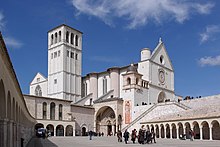

Films
- The Flowers of St. Francis, a 1950 film directed by Roberto Rossellini and co-written by Federico Fellini. Francis was played by Nazario Gerardi, a Franciscan friar from the monastery Nocera Inferiore.
- Benedictinenun.
- Francesco di Assisi, a 1966 made-for-television film directed by Liliana Cavani, starring Lou Castel as Francis.
- The Hawks and the Sparrows, a 1966 film directed by Pier Paolo Pasolini
- Brother Sun, Sister Moon, a 1972 film by Franco Zeffirelli, starring Graham Faulkner as Francis.
- Francesco, a 1989 film by Liliana Cavani, contemplatively paced, follows Francis of Assisi's evolution from rich man's son to religious humanitarian, and eventually to a full-fledged self-tortured saint. Francis is played by Mickey Rourke.
- St. Francis, a 2002 film directed by Michele Soavi, starring Raoul Bova as Francis.
- Clare and Francis, a 2007 film directed by Fabrizio Costa, starring Mary Petruolo and Ettore Bassi
- Malayalam film
- Finding St. Francis, a 2014 film directed by Paul Alexander
- L'ami – François d'Assise et ses frères (The friend – Francis of Assisi and his brothers),[90] a 2016 film directed by Renaud Fely and Arnaud Louvet starring Elio Germano
- The Sultan and the Saint,Alexander Kronemer, starring Alexander McPherson
- Sign of Contradiction,[91] a 2018 documentary film featuring commentary by Fr. Dave Pivonka, Cardinal Raniero Cantalamessa, and others, focusing on a revealing of the true St. Francis to modern audiences.
- In Search of St. Francis of Assisi,[92] documentary featuring Franciscan friars and others
- The Letter: A Message for our Earth, a 2022 film on YouTube Originals by Nicolas Brown, telling the story of Saint Francis and the encyclical 'Laudato Si'.[93]
Music
- Franz Liszt:
- Cantico del sol di Francesco d'Assisi, S.4 (sacred choral work, 1862, 1880–81; versions of the Prelude for piano, S. 498c, 499, 499a; version of the Prelude for organ, S. 665, 760; version of the Hosannah for organ and bass trombone, S.677)
- St. François d'Assise: La Prédication aux oiseaux, No. 1 of Deux Légendes, S.175 (piano, 1862–63)
- Gabriel Pierné: Saint François d'Assise (oratorio, 1912)
- William Henry Draper: All Creatures of Our God and King (hymn paraphrase of Canticle of the Sun, published 1919)
- Mario Castelnuovo-Tedesco: Fioretti (voice and orchestra, 1920)
- Gian Francesco Malipiero: San Francesco d'Assisi (soloists, chorus and orchestra, 1920–21)
- Hermann Suter: Le Laudi (The Praises) or Le Laudi di San Francesco d'Assisi, based on the Canticle of the Sun, (oratorio, 1923)
- Canticle of the Sun(soloists, chorus and orchestra, 1928)
- Paul Hindemith: Nobilissima Visione (ballet 1938)
- Leo Sowerby: Canticle of the Sun (cantata for mixed voices with accompaniment for piano or orchestra, 1944)
- Francis Poulenc: Quatre petites prières de saint François d'Assise (men's chorus, 1948)
- Seth Bingham: The Canticle of the Sun (cantata for chorus of mixed voices with soli ad lib. and accompaniment for organ or orchestra, 1949)
- William Walton: Cantico del sol (chorus, 1973–74)
- Olivier Messiaen: St. François d'Assise (opera, 1975–83)
- Juliusz Łuciuk: Święty Franciszek z Asyżu (oratorio for soprano, tenor, baritone, mixed chorus and orchestra, 1976)
- Peter Janssens: Franz von Assisi, Musikspiel (Musical play, text: Wilhelm Wilms, 1978)
- Michele Paulicelli: Forza venite gente (musical theater, 1981)
- John Michael Talbot: Troubador of the Great King (1981), double-LP composed in honor of the 800th birthday of St. Francis of Assisi.
- Karlheinz Stockhausen: Luzifers Abschied (1982), scene 4 of the opera Samstag aus Licht
- Libby Larsen: I Will Sing and Raise a Psalm (SATB chorus and organ, 1995)
- Sofia Gubaidulina: Sonnengesang (solo cello, chamber choir and percussion, 1997)
- Juventude Franciscana: Balada de Francisco (voices accompanied by guitar, 1999)
- Angelo Branduardi: L'infinitamente piccolo (album, 2000)
- Lewis Nielson: St. Francis Preaches to the Birds (chamber concerto for violin, 2005)
- Peter Reulein (composer) / Helmut Schlegel (libretto): Laudato si' (oratorio, 2016)
- Daniel Dorff: Flowers of St. Francis (solo for Bass Clarinet, 2013)
- Mel Hornyak & Elliot Valentine Lee: Litany of the Martyrs, appears in Adamandi (musical number, 2022)
Selected biographical books
Hundreds of books have been written about him. The following suggestions are from Franciscan friar Conrad Harkins (1935–2020), director of the Franciscan Institute at St. Bonaventure University.[94]
- Paul Sabatier, Life of St. Francis of Assisi (Scribner's, 1905).
- Johannes Jurgensen, St. Francis of Assisi: A Biography (translated by T. O’Conor Sloane; Longmans, 1912).
- Arnaldo Fortini, Francis of Assisi (translated by Helen Moak, Crossroad, 1981).
- Nikos Kazantzakis, Saint Francis (Ο Φτωχούλης του Θεού, in Greek; 1954)
- John Moorman, St. Francis of Assisi (SPCK, 1963)
- John Moorman, "The Spirituality of St. Francis of Assisi" (Our Sunday Visitor, 1977).
- Erik Doyle, St. Francis and the Song of Brotherhood (Seabury, 1981).
- Raoul Manselli, St. Francis of Assisi (translated by Paul Duggan; Franciscan, 1988).
Other
- In Rubén Darío's poem "Los Motivos del Lobo" ("The Reasons of the Wolf") St. Francis tames a terrible wolf only to discover that the human heart harbors darker desires than those of the beast.
- In Fyodor Dostoevsky's The Brothers Karamazov, Ivan Karamazov invokes the name of "Pater Seraphicus", an epithet applied to St. Francis, to describe Alyosha's spiritual guide Zosima. The reference is found in Goethe's Faust, Part 2, Act 5, lines 11,918–25.[95]
- In Mont Saint Michel and Chartres, Henry Adams' chapter on the "Mystics" discusses Francis extensively.
- Francesco's Friendly World was a 1996–97 direct-to-video Christian animated series produced by Lyrick Studios that was about Francesco and his talking animal friends as they rebuild the Church of San Damiano.[96]
- Rich Mullins co-wrote Canticle of the Plains, a musical, with Mitch McVicker. Released in 1997, it was based on the life of St. Francis of Assisi, but told as a Western story.
- Bernard Malamud's novel The Assistant (1957) features a protagonist, Frank Alpine, who exemplifies the life of St. Francis in mid-20th-century Brooklyn, New York City.[citation needed]
- G. K. Chesterton's book St. Francis of Assisi, a biographical and philosophical explanation of St. Francis[97]
See also
- Feast of Saint Francis
- St. François d'Assise, an opera by Olivier Messiaen
- Blessing of animals
- Fraticelli
- List of places named after St. Francis
- Pardon of Assisi
- St. Francis of Assisi, patron saint archive
- Society of St. Francis
- St. Benedict's Cave, which contains a portrait of Francis made during his lifetime
- St. Juniper, one of Francis' original followers
- Wolf of Gubbio
Prayers
- Canticle of the Sun, a prayer by Francis
- Little Office of the Passion, composed by Francis
- Prayer of St. Francis, a prayer often misattributed to Francis
Notes
- ^ The tunic that Saint Francis actually wore was simpler.[1] It reportedly was made by himself to be unattractive and uncomfortable,[2] unlike today's Franciscan habits.[3]
- ^ His mother was French and that may be why he was known as Francesco (Francis), name with the possible meaning "Frenchman".
- ^ The Christmas scenes made by Saint Francis at the time were not inanimate objects, but live ones, later commercialised into inanimate representations of the Blessed Lord and His parents.
- ^ e.g., Jacques de Vitry, Letter 6 February or March 1220 and Historia orientalis (c. 1223–1225) cap. XXII; Tommaso da Celano, Vita prima (1228), §57: the relevant passages are quoted in an English translation in Tolan 2009, pp. 19– and Tolan 2009, p. 54 respectively.
- ^ e.g., Chesterton, Saint Francis, Hodder & Stoughton (1924) chapter 8. Tolan 2009, p. 126 discusses the incident as recounted by Bonaventure, an incident which does not extend to a fire actually being lit.
- ^ For grants of various permissions and privileges to Francis as attributed by later sources, see, e.g., Tolan 2009, pp. 258–263. The first mention of the Sultan's conversion occurs in a sermon delivered by Bonaventure on 4 October 1267. See Tolan 2009, p. 168
- ^ On the day of his election, the Vatican clarified that his official papal name was "Francis", not "Francis I". A Vatican spokesman said that the name would become Francis I if and when there is a Francis II.[61][65]
References
- ^ Bryner, Jeanna (10 September 2007). "Tunic Worn by Saint Francis Identified". LiveScience. Retrieved 18 December 2023.
- ^ Wolf, Kenneth (March 2003). "St. Francis and His Tunic". Oxford Academic. Retrieved 18 December 2023.
- ^ Graves, Jim (22 March 2019). "7 Religious Talk About the Habits They Wear". National Catholic Register. Retrieved 18 December 2023.
but our habits are comfortable to wear
- ^ a b c d e f g h i j k l Brady & Cunningham 2020.
- ^ Pavia, Will (14 March 2013). "St Francis of Assisi: patron saint of the poor". thetimes.co.uk. News Corporation. Retrieved 29 May 2023.
- ^ Brooke 2006, pp. 161–162.
- ^ Zielinski, Karen (23 January 2019). "Begging like St. Francis". Global Sisters Report.
- ^ Delio 2013.
- ^ Tolan 2009.
- ^ Herbermann, Charles, ed. (1913). . Catholic Encyclopedia. New York: Robert Appleton Company.
- ^ a b c d e f g h i Herbermann, Charles, ed. (1913). . Catholic Encyclopedia. New York: Robert Appleton Company.
- ^ ISBN 0199566712.
- ^ "St. Francis of Assisi – Franciscan Friars of the Renewal". Franciscanfriars.com. Archived from the original on 15 December 2019. Retrieved 24 October 2012.
- ^ a b Chesterton, Gilbert Keith (1924). St. Francis of Assisi (14 ed.). Garden City, New York: Image Books. p. 158.
- ^ "St. Francis of Assisi". Catholic Online. Retrieved 22 September 2023.
- ^ Dagger, Jacob (November–December 2006). "Blessing All Creatures, Great and Small". Duke Magazine. Retrieved 1 December 2019.
- ^ ISBN 978-1-56619-516-4.
- ^ Chesterton (1924), pp. 40–41
- ^ a b Chesterton (1924), pp. 54–56
- ^ de la Riva, Fr. John (2011). "Life of St. Francis". St. Francis of Assisi National Shrine. Retrieved 11 June 2019.
- ^ Kiefer, James E. (1999). "Francis of Assisi, Friar". Biographical sketches of memorable Christians of the past. Retrieved 11 June 2019.
- ^ Chesterton (1924), pp. 107–108
- ^ Galli (2002), pp. 74–80
- ^ Chesterton (1924), pp. 110–111
- ^ "Secular Franciscan Order". Secular Franciscan Order US. Retrieved 13 January 2021.
- ^ Fioretti quoted in: St. Francis, The Little Flowers, Legends, and Lauds, trans. N. Wydenbruck, ed. Otto Karrer (London: Sheed and Ward, 1979) 244.
- ^ Chesterton (1924), p. 130
- ^ Runciman, Steven. History of the Crusades, vol. 3: The Kingdom of Acre and the Later Crusades, Cambridge University Press (1951, paperback 1987), pp. 151–161.
- ^ Tolan 2009, pp. 4–.
- ^ Tolan 2009, p. 5.
- Custodian of the Holy Land
- ^ Bonaventure (1867), p. 162
- ISBN 978-1-387-97789-5.
- ISBN 0-415-28473-2p. 44
- ISBN 978-1-4051-0846-1pp. 160–161
- ^ Chesterton (1924), p. 131
- ^ "Key to Umbria: Assisi". www.keytoumbria.com. Retrieved 9 May 2021.
- ISBN 0-900658-15-0.
- ^ a b c Bonaventure (1867), pp. 78–85
- ^ ISBN 978-1-61025212-6.
- ^ "Custody of the Holy Land". terrasanta.edu.jo. Retrieved 9 May 2021.
- ^ a b c Bonaventure (1867), p. 178
- ^ Warner OFM, Keith (April 2010). "St. Francis: Patron of ecology". U.S. Catholic. 75 (4): 25.
- ISBN 978-1576590034.
- ^ Hudleston, Roger, ed. (1926). The Little Flowers of Saint Francis. Archived from the original on 5 July 2019. Retrieved 19 September 2014.
- ^ Pope John Paul II (29 November 1979). "Inter Sanctos (Apostolic Letter AAS 71)" (PDF). Archived from the original (PDF) on 9 August 2014. Retrieved 7 August 2014.
- ^ Pope John Paul II (28 March 1982). "Angelus". Retrieved 9 June 2020.
- ^ Pope John Paul II (8 December 1989). "World Day of Peace 1990". Retrieved 24 October 2012.
- ^ Pope Francis, "Laudato Si': On care for our common home", Libreria Editrice Vaticana.
- ^ "Global Catholic climate group rebrands as Laudato Si' Movement", National Catholic Reporter, August 2, 2021.
- ^ Pappas, William. "The Patron Saint of Animals and Ecology", Earthday.org, October 6, 2016
- ^ Calendarium Romanum (Libreria Editrice Vaticana), p. 139
- ^ "The Stigmata of Saint Francis, Appearing and Disappearing in the Liturgy". Retrieved 9 May 2021.
- ^ "The Calendar". The Church of England. Retrieved 9 April 2021.
- ^ "St. Francis of Assisi". St. Francis of Tejas Church. Retrieved 2 February 2021.
- ISBN 0-225-66736-3.
- ^ Pope Francis (16 March 2013). "Audience to Representatives of the Communications Media". Retrieved 9 August 2014.
- ^ ISSN 1874-6691.
- ^ "Pope Francis explains decision to take St Francis of Assisi's name". The Guardian. London. 16 March 2013. Archived from the original on 17 March 2013.
- ^ News.va. 14 March 2013. Archivedfrom the original on 17 March 2013. Retrieved 4 January 2017.
- ^ Michael Martínez, CNN Vatican analyst: Pope Francis' name choice 'precedent shattering', CNN (13 March 2013). Retrieved 13 March 2013.
- ^ Laura Smith-Spark et al. : Pope Francis explains name, calls for church 'for the poor' CNN,16 March 2013
- ^ "Pope Francis wants 'poor Church for the poor'". BBC News. 16 March 2013. Retrieved 16 March 2013.
- ^ Alpert, Emily (13 March 2013). "Vatican: It's Pope Francis, not Pope Francis I". Los Angeles Times. Archived from the original on 15 March 2013. Retrieved 4 January 2017.
- ^ Pope Pius XII (18 June 1939). "Licet Commissa" (Apostolic Letter AAS 31, pp. 256–257)
- ^ "Saint Francis of Assisi". Franciscan Media. Retrieved 20 March 2019.
- ^ Laudato Si' Movement, "Who we are", retrieved March 2, 2023
- ^ a b "Feast of St. Francis of Assisi", Catholic News Service, October 4, 2018
- ^ a b c "Saint Francis of Assisi", Newman Connection
- ^ "Society of St Francis". anglicanfranciscans.org. Retrieved 25 January 2024.
- ^ "The Little Sisters of St. Clare". Archived from the original on 2 September 2010. Retrieved 16 April 2019.
- ^ Bliss, Peggy Ann (3 October 2019). "Animals to be blessed Saturday at Episcopal Cathedral" (PDF). The San Juan Daily Star. p. 20. Archived from the original (PDF) on 7 October 2019. Retrieved 6 October 2019.
- ISSN 2055-7973.
- ^ "Order of Lutheran Franciscans". Lutheranfranciscans.org. Retrieved 20 June 2015.
- ISBN 9780511978128.
- ^ "Manifestations - Questions & Answers".
- ^ Chapter 11 from "The Arena" by Ignatius Brianchaninov.
- ^ "Events, New Skete Monastery". newskete.org. Archived from the original on 19 November 2021. Retrieved 21 December 2019.
- ^ "St Francis of Assisi – What is Perfect Joy!". Eckhart Tolle Now. Retrieved 26 June 2019.
- ^ "Skanda Vale – Frequently asked questions". Skanda Vale. Retrieved 14 November 2018.
- ^ "Essay about St. Francis and the Franciscan Admonitions | Bartleby".
- ^ "Writings of St. Francis – Part 2". Archived from the original on 28 January 2013. Retrieved 17 January 2013.
- ISBN 978-0-52166622-0. Retrieved 31 December 2015.
- ISBN 0-385-02900-4. Archived from the originalon 12 August 2013.
- ISBN 2-85020-096-4.
- ^ Renoux, Christian. "The Origin of the Peace Prayer of St. Francis". Retrieved 9 August 2014.
- S2CID 240379755.
- ISSN 1522-7464.
- ^ "L'ami (2016)". imdb.com. 2016. Retrieved 25 November 2023.
The movie follows from 1209 to 1226 Elia da Cortona, one of the most faithful followers of S. Francis.
- ^ a b St. Francis of Assisi: Sign of Contradiction, retrieved 12 September 2023
- ^ In Search of Saint Francis of Assisi, Green Apple Entertainment. Retrieved 20 December 2019.
- ^ "Pope Francis YouTube Doc 'The Letter: A Message For Our Earth' Launches From Vatican City – Trailer". Variety. 4 October 2022. Retrieved 25 November 2022.
- ^ Harkins, Conrad (1994). "Francis of Assisi: Recommended Resources". Christianity Today. Archived from the original on 11 April 2021. Retrieved 11 April 2021.
- ^ Медведев, Александр (2015). ""Сердце милующее": образы праведников в творчестве Ф. М. Достоевского и св. Франциск Ассизский". Известия Уральского федерального университета. Серия 2: Гуманитарные науки. 2 (139): 222–233. Retrieved 11 July 2019 – via www.academia.edu.
- ^ "Mark Bernthal" (Video). www.markbernthal.com.
- ^ "St. Francis of Assisi by G. K. Chesterton". 1923.
General references
- Brady, Ignatius Charles; Cunningham, Lawrence (29 September 2020). "St. Francis of Assisi". Encyclopædia Britannica. Encyclopædia Britannica, Inc. Retrieved 5 October 2020.
- Brooke, Rosalind B. (2006). The Image of St Francis: Responses to Sainthood in the Thirteenth Century. Cambridge: University Press.
- Delio, Ilia (20 March 2013). "Francis of Assisi, nature's mystic". The Washington Post..
- Scripta Leonis, Rufini et Angeli Sociorum S. Francisci: The Writings of Leo, Rufino and Angelo Companions of St. Francis, original manuscript, 1246, compiled by Brother Leo and other companions (1970, 1990, reprinted with corrections), Oxford: Oxford University Press, edited by Rosalind B. Brooke, in Latin and English, ISBN 0-19-822214-9, containing testimony recorded by intimate, longtime companions of St. Francis.
- Francis of Assisi, The Little Flowers (Fioretti), London, 2012. limovia.net ISBN 978-1-78336-013-0.
- Bonaventure; Cardinal Manning (1867). The Life of St. Francis of Assisi (from the Legenda Sancti Francisci) (1988 ed.). Rockford, Illinois: TAN Books & Publishers ISBN 978-0-89555-343-0.
- Chesterton, Gilbert Keith (1924). St. Francis of Assisi (14th ed.). Garden City, New York: Image Books.
- Englebert, Omer (1951). The Lives of the Saints. New York: Barnes & Noble.
- Karrer, Otto, ed., St. Francis, The Little Flowers, Legends, and Lauds, trans. N. Wydenbruck (London: Sheed and Ward, 1979).
- ISBN 978-0-19-923972-6.
Further reading
- Acocella, Joan (14 January 2013). "Rich Man, Poor Man: The Radical Visions of St. Francis". The New Yorker. Vol. 88, no. 43. pp. 72–77. Retrieved 23 January 2015..
- Bonaventure, Saint Cardinal (1910). Little Flowers of St. Francis of Assisi. J.M. Dent; New York: E.P. Dutton.
- Brady, Kathleen (2021). Francis and Clare: The Struggles of the Saints of Assisi. Lodwin Press, New York. ISBN 978-1737549826.
- The Little Flowers [Fioretti] of Saint Francis (Translated by Raphael Brown), ISBN 978-0-385-07544-2.
- ISBN 0-375-40983-1.
- Giovanni Morello and Laurence B. Kanter, eds., The Treasury of Saint Francis of Assisi, Electa, Milan, 1999. Catalog of exhibition at the Metropolitan Museum of Art, March 16 – June 27, 1999.
- O'Reilly, Bernard (1897). . Beautiful pearls of Catholic truth. Henry Sphar & Co.
- Paul Moses, The Saint and the Sultan: The Crusades, Islam, and Francis of Assisi's Mission of Peace, New York: Doubleday, 2009.
- ISBN 0-670-03128-3.
- Augustine Thompson, O.P., Francis of Assisi: A New Biography, Cornell University Press, 2012.ISBN 978-0-80145070-9.
- ISBN 978-0-30017894-4.
External links
- "St. Francis of Assisi", Encyclopædia Britannica online
- "St. Francis of Assisium, Confessor", Butler's Lives of the Saints
- The Franciscan Archive
- St. Francis of Assisi – Catholic Saints & Angels
- Here Followeth the Life of St. Francis from Caxton's translation of the Golden Legend
- Colonnade Statue in St. Peter's Square
- Founder Statue in St. Peter's Basilica
- "The Poor Man of Assisi". Invisible Monastery of charity and fraternity – Christian prayer group. Archived from the original on 23 March 2018.
- Works by or about Francis of Assisi at Internet Archive
- Works by Francis of Assisi at LibriVox (public domain audiobooks)

- Saint Francis of Assisi Exhibition at the Mary Wellesley "St Francis of Assisi", London Review of Books, 27 July 2023.


